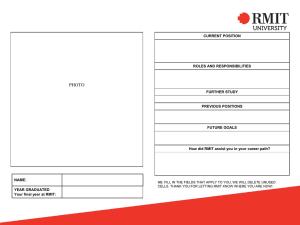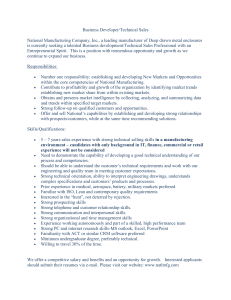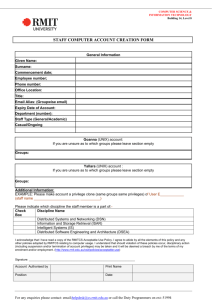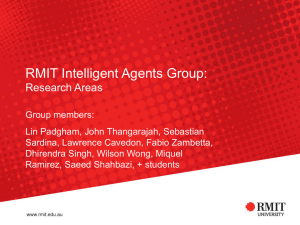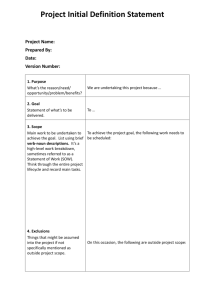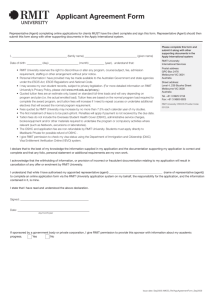Paper - Avetra
advertisement
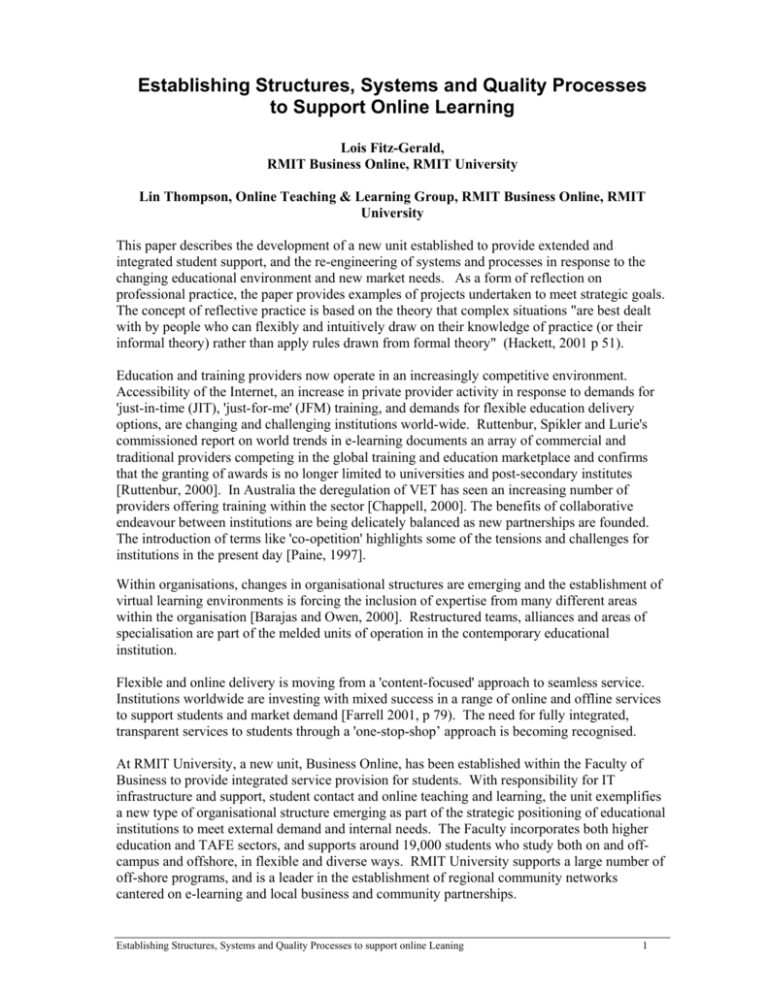
Establishing Structures, Systems and Quality Processes to Support Online Learning Lois Fitz-Gerald, RMIT Business Online, RMIT University Lin Thompson, Online Teaching & Learning Group, RMIT Business Online, RMIT University This paper describes the development of a new unit established to provide extended and integrated student support, and the re-engineering of systems and processes in response to the changing educational environment and new market needs. As a form of reflection on professional practice, the paper provides examples of projects undertaken to meet strategic goals. The concept of reflective practice is based on the theory that complex situations "are best dealt with by people who can flexibly and intuitively draw on their knowledge of practice (or their informal theory) rather than apply rules drawn from formal theory" (Hackett, 2001 p 51). Education and training providers now operate in an increasingly competitive environment. Accessibility of the Internet, an increase in private provider activity in response to demands for 'just-in-time (JIT), 'just-for-me' (JFM) training, and demands for flexible education delivery options, are changing and challenging institutions world-wide. Ruttenbur, Spikler and Lurie's commissioned report on world trends in e-learning documents an array of commercial and traditional providers competing in the global training and education marketplace and confirms that the granting of awards is no longer limited to universities and post-secondary institutes [Ruttenbur, 2000]. In Australia the deregulation of VET has seen an increasing number of providers offering training within the sector [Chappell, 2000]. The benefits of collaborative endeavour between institutions are being delicately balanced as new partnerships are founded. The introduction of terms like 'co-opetition' highlights some of the tensions and challenges for institutions in the present day [Paine, 1997]. Within organisations, changes in organisational structures are emerging and the establishment of virtual learning environments is forcing the inclusion of expertise from many different areas within the organisation [Barajas and Owen, 2000]. Restructured teams, alliances and areas of specialisation are part of the melded units of operation in the contemporary educational institution. Flexible and online delivery is moving from a 'content-focused' approach to seamless service. Institutions worldwide are investing with mixed success in a range of online and offline services to support students and market demand [Farrell 2001, p 79). The need for fully integrated, transparent services to students through a 'one-stop-shop’ approach is becoming recognised. At RMIT University, a new unit, Business Online, has been established within the Faculty of Business to provide integrated service provision for students. With responsibility for IT infrastructure and support, student contact and online teaching and learning, the unit exemplifies a new type of organisational structure emerging as part of the strategic positioning of educational institutions to meet external demand and internal needs. The Faculty incorporates both higher education and TAFE sectors, and supports around 19,000 students who study both on and offcampus and offshore, in flexible and diverse ways. RMIT University supports a large number of off-shore programs, and is a leader in the establishment of regional community networks cantered on e-learning and local business and community partnerships. Establishing Structures, Systems and Quality Processes to support online Leaning 1 As a relatively new unit the challenges facing RMIT Business Online include: Identifying exactly what end-users (our students, clients and staff) require to improve their teaching/learning experience Finding efficient and effective ways of meeting the dual demands for product and service development to meet strategic targets of the faculty, and capacity building Managing multiple projects simultaneously and meeting the critical and often short, timelines Establishing policy and procedures, good working practice and effective quality controls Managing staff (fulltime, casual and contract staff working across multiple projects) and implementing more effective budget efficiencies and controls Developing a cohesive operational unit—bringing together different operational work units to work in collaborative partnership. The Literature While the literature does not provide ready solutions to the eclectic mix of challenges noted above, it has informed thinking. Principle learning include that: strategic planning and organisational positioning require thorough market analysis [Mitchel1, 1999; 1999a]; many different business models of e-learning operations exist [Ruttenbur et al, 2000]); there is a growing awareness at all levels within education of the need to systemise and measure flexible learning and online learning operations [Stewart-Rattray, Moran and Schueler, 2001; KPMG, 20001-2]; knowledge management is a key issue, but poorly managed in education; ‘value chains’ and business systems of all businesses are in the process of being redefined [Cutler, 1997]; and that roles are changing [Shapiro, 2000]. The literature also reinforces that the major asset of any organisation is its human capital: the power and potential of tapping collective knowledge, while ensuring that staff feel a sense of ownership and appreciation for their valued contribution. This idea is captured by Schofield, Walsh and Melville when they claim that 'time and time again, individuals identified the importance of the group in generating knowledge' Schofield et al, 2001 p 10). Few authors, however, discuss the re-engineering and alignment of internal systems that is the focus of this paper. Adopting A Strategic Focus A strategic focus of Business Online is to improve support services to students and staff. The strategy for achieving improved services is two-fold. Firstly, it involves improving the management of the faculty’s relationship with its students, captured in the acronym CRM (Client Relationship Management) and secondly, the implementation of efficient and effective business operations. The first strategy involved establishing a project for centralising and fully integrating all services provided to students. The second strategic project provided for an integrated and transparent set of services to improve online teaching and learning, administration, and research for staff and students in the faculty. Both are both based on a systems approach involving the use of technology, people and new processes. To achieve strategic objectives a number of concurrent projects were initiated: Establishment of a project management system to coordinate online projects and ensure policy and quality requirements are met Improvement of student and staff access to and use of IT facilities (including remote and OS dial-in, mapping of student location, use of Smart or magnetic cards, use of SMS for student notification etc) Establishing Structures, Systems and Quality Processes to support online Leaning 2 Establishment of a fully integrated help desk (and phone and email) as a one-stop-shop to answer all student queries Development of Program Portals to foster student e-Communities at Program level A research and development agenda within Business Online and with partners From the literature, four key themes for process and system establishment were identified: the need for an integrated systems approach; improving staff (and organisational) capability; collaboration; and embedding 'quality'. The outcomes of all the strategic projects undertaken have been mapped against these themes, which have been used as a basis for monitoring the success of the projects: 1. Integrated Systems Preliminary investigations showed that achieving the strategic focus in new systems development required examination of current process, the refinement and development of processes and systems, and most importantly the integration of systems (Peskin, 1996). The stages of developing an integrated system have included: Analysis of information flows and strengths and weaknesses of the current system Conceptual planning of a new integrated and holistic system design The definition and operationalisation of discrete sub-projects which would recombine to achieve project aims. 2. Improving Staff Capabilities A key institutional asset is the organisation’s human capital—the many dedicated staff working in new ways on new developments, in partnerships and independently. However, this asset is also the institution’s point of greatest vulnerability. Faculty staff were operating in a period of continued uncertainty and constant change, and careful management was required to achieve best outcomes while also providing them with a sense of ownership and job-satisfaction. 3. Collaboration To capitalise on future capabilities on offer through technology and advanced information and communication systems, partnering and collaboration are essential. 4. Embedding Quality Quality systems were embedded in each of the projects at the planning phase. Also, in order to meet future as well as present needs, the projects were grounded in the current research literature. Staff have been encouraged to reflect on their practice and to document that reflection, both on current literature and work undertaken on the projects as action research. Exploring the Project Models The first model, illustrated in Figure 1, highlights how interrelated business needs were converted into discrete projects with the principle aims of improving student and staff support and refining business systems. It also documents the key overarching principles of collaborative partnerships and work models, integrations of systems, improving staff capabilities and the need to embed quality. The first project from this set of drivers was the research and development associated with an integrated “One-Stop Shop” for student support (see Figure 2). The second project is focused on improving business operations and project management (see Figure 3). Establishing Structures, Systems and Quality Processes to support online Leaning 3 Figure 1: The Project Model STAFF CAPABILITIES QUALITY ASSURANCE PROJECT 1 PROJECT 2 Provide a single face-to-face poin of contact for all student queries Develop and maintain a knowledge base of all accurate responses to student queries Develop a phone and email back-end to one-stop shop Manage timelines in online projects Coordinate specialist Ed Design & Production staff Improving Student & Staff Support Use latest technologies to communicate with students INTERGRATED SYSTEMS Ensure quality at each stage of online course development Provide all academic & technical staff with access to Project information Develop Program Portals to foster student eCommunities Improve staff and student access to RMIT Business IT Systems PARTNERSHIPS & COLLABORATION Project 1 - Integrated One-Stop-Shop for Student Support This project was established to provide efficient and effective student interaction in a clearly defined central location and through a number of channels including face-to-face, phone and email. A knowledge bank of responses to the full range of student queries was developed and clear and simplified processes for dealing with student administration were documented and established. The next phase of implementation will focus on quality assurance and involve monitoring the progress of each student administration request as it is approved by academic and administrative staff in Schools and the negotiation of student service level agreements with schools. Integration of systems The one-stop-shop will integrate with, and inform the development of, a similar central university-wide facility that is soon to be established. Close interaction is to be established between staff in the Business Online Integrated Helpdesk and those in other similar facilities throughout the campus. Information on university wide information systems (such as the Distributed Learning System and Academic Management System) and services (student employment, health and housing services) will be available at the integrated helpdesk. Building staff capabilities and collaboration Front-line management skills and the development of strong client support attributes will be the focus of capability building activities for staff employed in the one-stop-shop. Opportunities for collaboration exist both within the Faculty and in the wider university. The possibility of forming partnerships with external service providers for provision of telephone support services (1900 numbers etc) is also being investigated. Establishing Structures, Systems and Quality Processes to support online Leaning 4 Embedding Quality Student forms lodged for processing at the Integrated Helpdesk, will be electronically logged before they are sent for approval to academic and administrative staff in Schools. Considerable work will be undertaken to establish Service Level Agreements between Schools and the Integrated Helpdesk, on behalf of students, for appropriate turnaround times for each of the student administration processes initiated at the Integrated Helpdesk. Formal telephone training for staff taking calls on the student hotline will involve call monitoring for the purpose of providing feedback to operators with the aim of improved service. Formal monitoring and version control of responses to students’ ‘frequently asked questions’ will ensure an accurate knowledge base for staff to work from. Figure 2: Project 1 – One-Stop-Shop Selection Course Advice Brochures etc STUDENT QUERIES Pre-requisites Cancellation of Enrolment Web-based forms Telephone Application for Award Exam and Timetable Information IT Support Needs Variation of Enrolments Graduation Information Student Support Services Face to Face Email Project 2 - Project Management System Project (PMSP) Activities were established to provide systems and processes to manage multiple projects (i.e. course development and other projects) in a more coordinated way; to coordinate tasks performed by different teams; and to manage staffing requirements more cost-effectively - in particular the use of external contract and specialist staff employed to cater for the peaks and troughs of development cycles and project requirements. MS Project 2000 was chosen as the project management platform as it supported the management of multiple projects, devolved project leadership and met the required information management and reporting needs. Later system migrations to Web Central, a network communications option in the application, will enable web communication about project matters (e.g. timelines, task lists, progress checks, and receive updates and project reports) without the need for staff to interact with MS Project directly. Simply described, the system developed allows separate project management files to be created for each project and managed by individual project leaders, but which are linked to a central Master Project file that controls resource allocation and leveling across all projects. Establishing Structures, Systems and Quality Processes to support online Leaning 5 Figure 3: Project 2 - PMSP Project Model Information Mgmt: policy tools documentation QA - etc Resource Management Master Project Templates /Project tasks Project 1 Client Project 2 Systems Project 3 Staff Integration of systems A major challenge for Business Online was the bringing together of previously separate work groups (Multimedia Production, Educational Design, and Copyright and IP Management) to work as a coordinated unit. Each group had its own procedures and processes, and while they were connected at the periphery, no group was fully aware of the detail of the operations and activities of any other. In addition, the Faculty was required to work with the wider university resources and processes: quality management for example is the joint responsibility of the Faculty and central quality units. The construction of the PMSP model and system provided the opportunity to examine the tasks undertaken by the collective group in relation to online course and product development projects, the accompanying policies and procedures, and the interrelationships between them. Working together, the groups developed a single master template (an MS Project task file), listing all tasks, sub-tasks and descriptions of related processes and forms. This template forms the basis of negotiations with project teams and their clients in the construction of individual project agreements. The template is modified or extended according to the unique needs of each project, but always incorporates task lists, procedures, tips, quality assurance milestones, tools and instruments to assist in the implementation each project. In the PMSP model, this modified template file becomes the individual project file and is linked to the Master Project file - becoming a sub-project within the master file. At the top level, each project is managed by the overall project director (Manager, Teaching and Learning Online). Responsibility for the day-to-day running of the project remains with the individual project leader. Building staff capabilities and collaboration Using a bottom-up development approach, staff from the three groups were involved from the inception of the project. The development of the template was an enlightening process for all of them. For the first time members of the different groups began to understand more fully how each other worked, so that the sequencing of activities, and inter-relationships between activities, became clearer. A key benefit of this change was that staff took ownership and actively looked for ways of improving procedures and processes. Development of the PMSP was the first major Establishing Structures, Systems and Quality Processes to support online Leaning 6 activity of the new combined team and has strengthened the capabilities of staff both collectively and individually. The group is now working with other groups in the university to share and extend the work undertaken and to refine the base system. The MS Project Central component has not yet been implemented but will be the next phase. Summary The two major projects outlined above are examples of work undertaken to achieve the strategic aim of the Faculty of Business through RMIT Business Online. The first project is the establishment of an Integrated Helpdesk (one-stop-shop), implemented to improve the management of the Faculty’s relationship with student-clients. The second project is the development of an Online Project Management system as an example of the implementation of efficient and effective business operations with a strategic focus. In addition to meeting Faculty strategic goals, the implementation of these projects also supports general Faculty goals such as building integrated systems, improving staff capabilities, fostering collaboration and embedding quality in Faculty systems. Opportunities for future research The work undertaken to date has highlighted several issues that are being considered for further research, including Facilitating action research and reflective practice Doing more as the budget grows tighter Keeping focus on strategic intent to maintain a client focus Improving staff capabilities and morale References Barajas M & Owen M (2000), Implementing Virtual Learning Environments: Looking for Holistic Approach. Pre-discussion paper based on the results of IVETTE study. [3(3)]. http://ifets.ieee.org/periodical/vol_3_2000/barajas.html Chappell C (2000), The new VET professional; culture, roles & competence. RCVET Working Paper 00.41. UTS Research Centre for Vocational Education and Training. Cutler T (1999), A National Policy Framework for Structural Adjustment within the New Commonwealth of Information. http://www.ipac.gov.au/report2/index.html Farrell G (1999), The Development of Virtual Education: A global perspective. The Commonwealth of Learning. July 6 http://www.col.org/virtualed/index.htm Farrell G (2001), The Changing Faces of Virtual Education. The Commonwealth of Learning. http://www.col.org/virtualed Hackett S. (2001). Educating for competency and reflective practice: fostering a conjoint approach in education and training. Journal of Workplace Learning Vol 13, No 3. pg 105 The Institute for Higher Education Policy, 2000, Quality on the Line: Benchmarks for Success in Internet-based Distance Education, Washington, DC. http://www.ihep.com/quality.pdf Johnston R. (1999). The position of human resource developers in the new learning landscape: A discussion paper. RCVET Working Paper 99.30. UTS Research Centre for Vocational Education and Training. Establishing Structures, Systems and Quality Processes to support online Leaning 7 KPMG & Lifelong Learning Associates (to be published), Evaluation of the Australian Flexible Learning Framework, December report to the ANTA Steering Committee. Mitchell J (1999), Business Models for Developing Online Learning Systems: Findings from Current Research. Paper presented. ANTA NET*Working 99 Online Conference. JulyAugust. Mitchell J (1999a), Business Models for Flexible Delivery and Online Learning Systems in VET: Findings from Two National ANTA Projects in 1999 and from other research. Paper presented International Vocational Education and Training Annual Conference. 11-13 August 1999. Sydney. http://www.jma.com.au/openiveta.htm Noonan P (2001), Critical Success Factors for TAFE, Seminar paper, CEET, Melbourne. http://www.education.monash.edu.au/centres/ceet/pdf/Peter%20noonan.pdf Paine, N (1997) Conference closing summary, NET*Working 97 Conference- shaping the Online Learning Environment, ANTA National Flexible Delivery Physical and Online Conference, Adelaide Nov 19-21. http://www.nw97.edu.au/frame-phys.html Peskin, M (1996) Measuring the quality of computer systems development, Benchmarking for Quality Management and Technology, Vol 3, No.2, pp68-84. MCB University press. Ruttenbur BW , Spickler G C, & Lurie S (2000), E-Learning: The Engine of the Knowledge Economy, Morgan Keegan & Co Inc. Members New York Stock Exchange. July http://www.masie.com/report9 Schofield K, Walsh A, & Melvile B (2001), Online Learning and the New VET Practitioner: Implications for the Organisation of their Work. RCVET Working Paper 2001. http://www.uts.edu.au/fac/edu/rcvet/working%20papers/0022Schofield.pdf Shapiro, G. (2002) Employee involvement: opening the diversity Pandora’s Box? Personnel Review, Vol. 29, No.3 pp304-323. MCB University Press. Steward-Rattray J, Moran L & Schueler (2001), The Scope of Flexible Learning and Implications for Improved Data Collecting and Reporting Systems. NCVER. Establishing Structures, Systems and Quality Processes to support online Leaning 8
